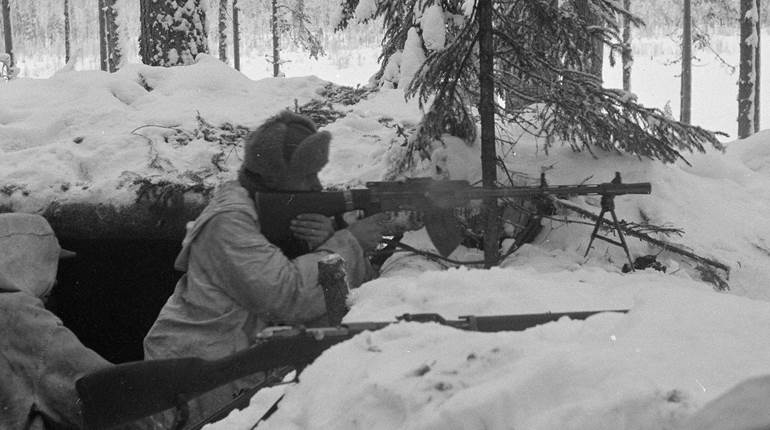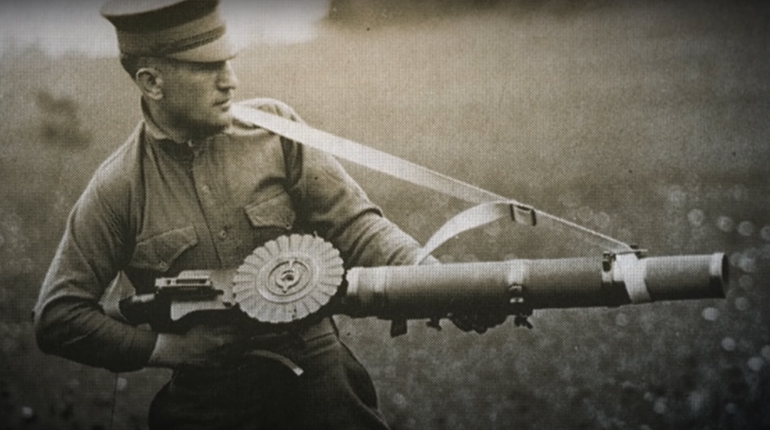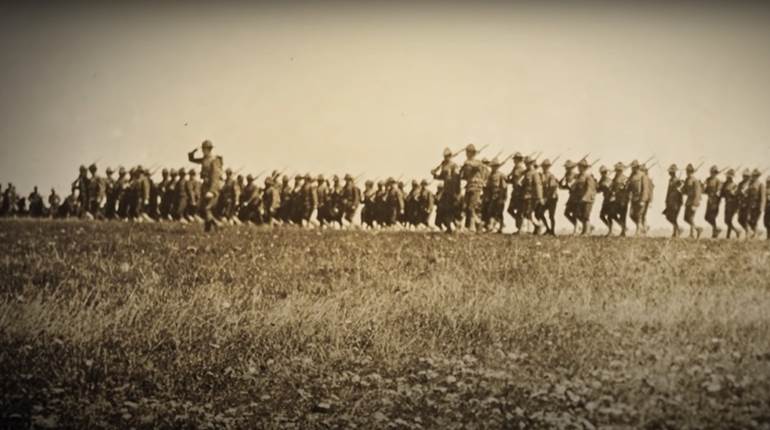
SMLE Mk III rifles such as the example at left, which was made by the Birmingham Small Arms Co. in 1913, served the British “Tommy” well in the harsh conditions of World War I. That included “going over the top” during the horrific Battle of the Somme in 1916.
This article was first published in American Rifleman, June 1999.
From the muddy trenches of Flanders to the sun-baked shores of Gallipoli, the Short, Magazine Lee-Enfield Mk III rifle in the hands of the British Army proved itself up to the demanding service conditions of World War I. The roots of the SMLE date back to the bolt-action Lee-Metford Rifle in .303 cal. adopted by the British Government in 1888 as a replacement of the single-shot Martini-Henry. The Lee-Metford employed the shallow, seven-groove rifling designed by William Ellis Metford and a magazine system invented by American James Parris Lee.

The rifle featured an eight-shot-capacity, detachable box magazine and a cut-off that protruded from the right side of the receiver.
When in the closed position, this device blocked the magazine, so that the rifle was used normally as a single shot by dropping a cartridge onto the top of the cut-off and closing the bolt. The Acceptance Board of the day felt that allowing magazine fire would encourage troops to waste ammunition, so the rifle was to be employed as a single-loader with the magazine in reserve to be used only in an emergency.

This method of shooting was used in the Boer War (1899-1902) when the British learned some painful lessons about the advantages of charger loading, the ability to effectively use the rifle in rapid fire, and most importantly, marksmanship or “musketry” training. British infantrymen were generally issued the “long” Lee-Enfield with a 30 1⁄2" barrel, whereas cavalry units were issued 20 1⁄2"-barrelled carbines. The British adopted the deeper, five-groove Enfield rifling in 1895, and the new rifle was dubbed the Magazine Lee-Enfield Rifle Mk I. Magazine capacity had been increased to 10 rounds.
The British Army fared badly in long-range musketry duels against the Boers, but it did have one advantage. On the left side of the rifle’s fore-end, just forward of the rear sight, was a brass disc in the form of a dial, with a thin piece of metal attached. The end of the metal, or upright, was in a “V” shape, with the opposite end having a small hole in which a small foresight tip was attached. On the left rear of the receiver was a long stem with a fixed aperture at the top. When not in use, this folded beside the receiver. The rifles had conventional sights, and the arrangement described was referred to as “random” or “volley” sights. The cartridge’s trajectory was stamped on the dial on the front sight piece. The arrow at the end of the foresight was turned to the appropriate number, and the rear sight raised.

With the sights elevated volleys could be fired. Usually, this tactic was employed when large numbers of troops were engaged at ranges far beyond those recognized for accurate shooting. The idea was that the trajectory would ensure those bullets were coming back to earth to cause maximum discomfort to the enemy. The theory was later called the “beaten zone” technique. The purpose was to break up concentrations of enemy troops, and the technique was used by the British in World War I.
On December 23, 1902, the British Army accepted the Short, Magazine Lee-Enfield (SMLE) into service. The rifle was an answer to the complaints that had been received, and featured a number of alterations. Barrel length was 25 3⁄16", and the sights were improved. The random sight was retained, and the bolt face and receiver were modified to accept a charger. The rifle was for issue to both infantry and cavalry units, so there was no longer a need for separate rifles and carbines.
Lord Roberts, one of Britain’s most distinguished soldiers, had become commander-in-chief of the British Army, and it fell to him to oversee and implement new tactics and techniques for the army. A great concern with the SMLE was the loss of reach in bayonet fighting that the shorter barrel gave. At a time when all regular armies were trained in the use of the bayonet, this was viewed as a serious deficiency. Lord Roberts had the length of the bayonet increased to make up for the shorter barrel length so there was no loss in reach. Utterly practical, it resulted in the SMLE bayonet being one of the most fearsome looking of any type in use at the time.

Lord Roberts also outlawed the single loading of individual cartridges in British service. The cut-offs were to be left open and the magazines were to be loaded only by charger. The chargers held five cartridges each and two were required per magazine. Rapid reloading became a reality and the small regular army was thoroughly trained until a high level of dexterity was achieved. Roberts was determined that when the pending European conflict came—which seemed inevitable in the first decade of this century—the British and Empire servicemen would be second to none in marksmanship.
Roberts ensured Britain’s small standing army was the most efficient by improving training. He instituted research into rapid-fire techniques, and here he was aided by the SMLE’s design. All marks of the SMLE have a smoother bolt throw that of any other bolt action, save perhaps the U.S. Krag, and the rear-positioned bolt lugs allowed a very short throw. This combination with the new loading methods would allow a rate of fire unmatched by any other bolt rifle.

The shooting method eventually adopted was simple, but almost revolutionary. The loaded rifle was placed at the shoulder, a shot was fired and the rifle was held in position by the left or supporting arm. The shooting arm was removed from the small of the butt, sweeping upwards to the turned down bolt handle, which was in the ideal position for rapid fire. The open hand on the shooting arm then slapped the bolt upwards and rearwards, extracting and ejecting the fired cartridge. At the end of the bolt travel, the open hand was turned slightly and the bolt pushed forward, cocking the rifle and chambering a fresh round. The bolt handle was turned down and, when the hand left the bolt handle it was in the ideal position for the trigger finger to return to the trigger and the hand to the small of the butt. It was found that a rate of up to 35 aimed shots per minute could be fired if the rifle was held in this position while chargers were employed to replenish the magazine.
Roberts directed that intensive training be given in all positional shooting. This covered offhand, kneeling, crouching and sitting, as well as the traditional prone position. He encouraged inter-unit shoots with donations of prizes, and, when he was satisfied with the standards of marksmanship, he directed the troops be given training in snap shooting, night shooting and shooting in high winds. He ensured that this training was given to regular and militia forces throughout the Empire. After Lord Roberts’ retirement in 1904, the same practical training and high standards were maintained.
There were some changes to the rifle in 1908: The charger guide was altered and removed from the receiver and replaced by a bridge over the receiver. It was then designated as the SMLE Mk III. It was with that rifle that Britain and most of the Empire entered World War I. At the outset of war, Britain immediately designated most of its regular army as the British Expeditionary Force (BEF) and committed its troops to Europe. It is sufficient to state that the Allies were “outgeneralled” early in the conflict, and the BEF, or “Contemptible Little Army” as the Kaiser referred to them, were retreating early. The British had relatively few machine guns, and the beaten zone tactic with rifles was regularly employed.
During the retreat from Mons and Arras, the BEF was almost fully engaged. It followed the marksmanship training its troops had received, and the German advance was halted. The rate of accurate fire was unbelievable to the Germans who were not trained in such methods. The Mauser could not be manipulated nearly as quickly, and the Germans thought the British were using massed machine guns rather than rifles.

Under service conditions, particularly in trench warfare, another advantage of the SMLE was discovered. The absence of front bolt lugs, and the receiver recess necessary for them to lock into, made the SMLE less prone to jamming with dirt or mud and easier to clean. It is not an exaggeration to state that the simple and foolproof Lee-Enfield withstood greater abuse and usually gave less trouble than its contemporaries. The Mauser, as a military rifle in 1914, was slightly inferior to the SMLE. The advantages were a smoother and quicker bolt throw, larger magazine capacity and shorter barrel. Mausers never saw the day they could compete with the SMLE as a military rifle in speed of bolt manipulation, magazine capacity and ability to take sand, dirt, mud and abuse in stride and still come up shooting.

The small BEF was almost destroyed in the carnage of World War I. Its place was taken by volunteers who—due to time limitations—could not be given the same intensive marksmanship training. The marksmanship standard was still high, though, and rapid fire—while not quite as fast—was still the highest of any army in the world.
At Gallipoli and in the Middle East where much of the Australian and New Zealand Army Corps (ANZACs) fought, it was a different matter. Here the Australians, British and New Zealanders learned the advantages of marksmanship, rapid fire and accurate shooting.

The Turks prized individual marksmanship as much as the British and Australians. In 1914, they had the largest body of specialist snipers per number of troops in the world. Most of their troops had marksmanship training and long-range musketry duels were a feature of the Middle East campaign. The Australian Imperial Force (AIF) was the equal of the Turkish Army in these duels. In an area where fixed positions were not as relied on as in France and the machine gun was not as common, the rifleman ruled the battlefield.
The advantages of rapid fire were also to be proved yet again. When the Turks employed human-wave attacks, the Australians came up with a tactic that made them extremely costly. They modified the rapid-fire technique so that more than 50 to 55 aimed shots per minute could be fired.

The tactic was to fire in conventional rapid-fire mode until the enemy was approximately 100 to 150 yds. away. Then the right hand would leave the small of the butt, and the thumb and first finger would grasp the bolt handle. The little or lower finger was then used to fire the rifle, and the bolt cycled using those two fingers, which stayed on the bolt handle until the rifle was empty. As soon as the bolt handle was down, the trigger was then pulled and the cycle recommenced. As the targets appeared, a quick snap shot was made. The bolt was already working and the recoil was utilized with the disturbance in moving the bolt to align on the next target which was again snap shot. Attention was given to the target only until the shot was made. There was no checking to see if it was a hit or miss, personal instinct saw to that. If he missed first off, the shooter or one of his mates would doubtless see the target again.
Contemporary accounts mention this tactic and one stated “the sight of Jacko [the colloquial name for the Turks during this conflict] running towards you with the sun glittering off his bayonet and blood in his eye was sufficient incentive to make you keep that bolt flying.” It might sound desperate, and has no place on a target range, but, against a man moving toward you, it was effective.

The SMLE performed so well in the “War to end all Wars” that it was retained, and despite Britain’s going to the No. 4 Mk I Lee-Enfield, some other members of the British Commonwealth were reluctant to retool for the new rifle, and kept the SMLE in production. When Britain went to war again in 1939, the changeover was not complete, and rifles of both Marks went to France.
The Lee Enfield of both Marks soldiered through World War II, and later Korea. Australian troops were still armed with the SMLE through Korea, and the SMLE rifle itself stayed in production “Down Under” until 1957.
As a military arm, the Lee-Enfields have been long since superseded. The old “smellie” or “three oh” has had many myths built around it. It never needed them, as it was quite capable of standing on it’s own two feet.






































